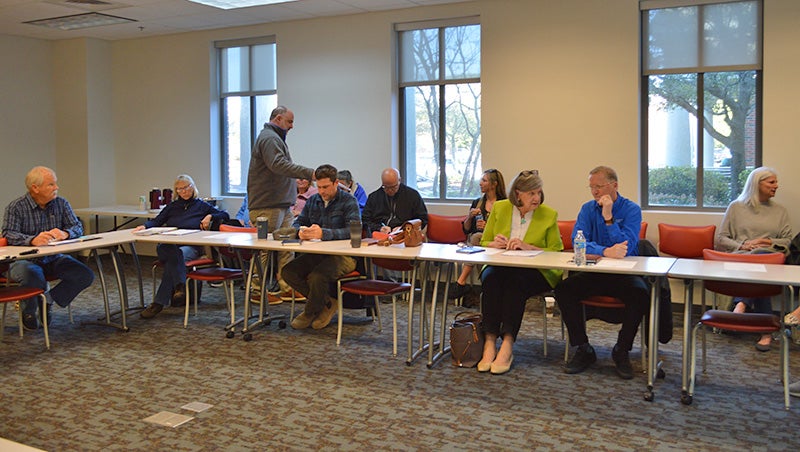Dare Housing Task Force covers ground in two meetings
Published 8:42 am Monday, April 1, 2024

- Members of the Dare County Housing Task Force sitting at the tables and members of the public begin to gather for the March 19 meeting. Mary Helen Goodloe-Murphy photo
|
Getting your Trinity Audio player ready...
|
Two times now the Dare County Housing Task Force has gathered in a smallish meeting room on the first floor in the Dare County Administration Building.
Some 26 members have been appointed to the task force (see listing of members here). A dozen members represent the towns, usually an elected official and someone from the planning department. A dozen members are from interest groups and sectors of the economy, like restaurants, hoteliers, Realtors®, builders, four as residents, the hospital, the visitors bureau and the county’s Board of Education.
Leading the group are Dare County Board of Commissioners Chairman Robert L. Woodard and county manager Robert L. Outten.
Housing for workforce or essential workers is an ongoing problem in Dare County.
First Meeting
Outten says the county has worked on the problem for about 30 years.
About 20 years ago, the county set up a Community Development Corporation. The corporation produced six apartments in Nags Head. It morphed into a non-profit group and then faded away.
A North Carolina state economic development study was next.
This Board of Commissioners set about to do something about housing and hired the Outer Banks Chamber of Commerce, which proved unsuccessful.
A group at University of North Carolina at Chapel Hill was engaged and did studies. Outten summarized the findings as “you all have a significant housing problem.”
Two years ago, the Dare County Tourism Board brought in consultants, who said “you can’t do anything until the housing problem is fixed.”
Outten said Dare County needs roughly 3,000 housing units. “We’re not going to build our way out by adding stock,” said the county manager.
At that first meeting in January, Woodard asked a two-part question: Do you agree that we have a workforce/essential housing problem in Dare County and are you willing to be a part of finding a solution and support?
Everyone sitting around the tables agreed. “That’s unanimous. That’s encouraging.”
Task force members then commented on the effects of not enough workers and looked at problem-solving.
Bob Peele with the Outer Banks Chamber of Commerce did the restaurant numbers. Restaurants are closing two days a week; that’s eight days a month. Over the year, the establishment has lost a month of income. Some 27 years ago, most restaurants worked seven days a week in season. Five or six years ago, many restaurants used to serve lunch. Now only dinner. Sunday brunch was often dropped because owners can’t afford to pay overtime.
“We really need more housing,” said Sherry Wickstrom, Manteo’s mayor. She advocated a multi-prong approach and creating a comprehensive patchwork.
Overcoming “not in my back yard” or NIMBY is obviously an attitude to be tackled, commented one town’s representative.
By the end of that first meeting, Outten ran down the work to be done:
– Mission statement and goals.
– Target markets, broad spectrum.
– Beyond just building; want ideas and options.
– Immediate time frame. $35 million; how we go about using it.
– Must be efficient use of money and land.
– Can’t be just a county project.
– Restrictions on local and county government; how set up for private sector.
Second Meeting
Immediately and without discussion, the task force approved a mission statement proposed by Donna Creef of the Outer Banks Home Builders Association. (See mission statement here.)
This March 19 meeting’s first item was “Target Market,” the initial item on Outten’s list.
He opened the meeting by saying the county had a “broad spectrum of housing needs.”
Do we go after all the needs or narrow the approach? What are the targets?
Outten said the county is restricted to building low-income housing; the towns have more flexibility. And he said no government subsidy is available.
Ronnie Sloan with the Outer Banks Hospital listed how the hospital is addressing its needs.
Two members said staff members were living out of the county, in Columbia and Currituck.
Then a participant from Duck said, “We recruit from one another,” which drew chuckles. “It’s not sustainable.”
Malcolm Fearing argued that the best pathway solution was homeownership. “We can come up with a mechanism.”
The conversation worked around to what to do about three teachers in teacher housing that can’t finding housing and must move after the four years are over.
Fearing suggested that the towns “look at your rules to see how they apply to your constituents.”
Kitty Hawk suggested a “tool box” for towns.
Woodward then turned to public members for comments.
Carson Creef said look into transportation, making it easier to get back and forth to the beach. He also said “towns need to roll back restrictions.”
Someone from Kitty Hawk suggested redevelopment of current commercial properties by building above businesses and rezoning for mixed use.
The meeting concluded with two women telling their stories to the task force. One person said, “seniors need help.” She is being put out of her motor home. She can’t find a place to rent. “I’m not going to survive.”
About housing, the second person said “it’s an eastern North Carolina issue. Do a partnership with other counties.” About homelessness, she said “it’s real. It’s devastating.”
Before the end of the meeting, Katie Morgan asked about how much the Coastal Affordable Housing LLC had spent. Outten immediately responded.
The itemized invoice sent by Coastal Affordable Housing LLC was for the time period from Sept. 7, 2022 to April 30, 2023. The total invoice was for $389,633.73. A copy of the invoice, provided by Dare County, is shown here.
SUBSCRIBE TO THE COASTLAND TIMES TODAY!





